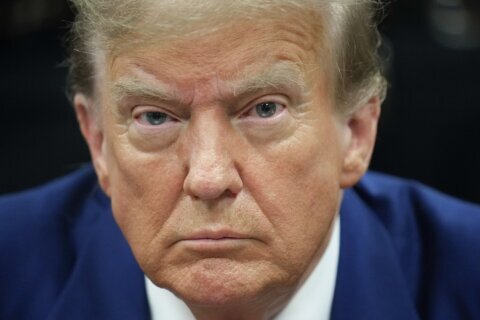Excerpts from recent editorials in the United States and abroad:
March 13
The Washington Post on bank bailouts
Over the weekend, the United States suffered the second- and third-largest bank failures in the country’s history. This wasn’t supposed to happen. A slew of protections were put in place after the financial crisis 15 years ago to prevent a repeat of big banks collapsing and nearly taking down the whole banking system with them.
But, once again, the federal government had to step in on Sunday evening with what amounted to a bailout of Silicon Valley Bank and Signature Bank — along with a bazooka of aid to prevent more banks from collapsing on Monday. It’s welcome news that the dramatic action appears to have prevented other regional banks from toppling, too, though no one should be pleased about the situation. Bankers were once again taking unwise risks, and regulators were once again too lax.
There’s more to learn about all the mistakes that led to this moment, but it’s already obvious midsize financial institutions need additional scrutiny. What is now apparent is that the list of “too big to fail” banks is far longer than most assumed. Congress and regulators have to face this new reality and rapidly adjust. Silicon Valley Bank was the nation’s 16th largest with about $200 billion in assets, and Signature Bank was the 30th largest with about $110 billion in assets.
These banks put profit over prudence. Silicon Valley Bank courted start-ups and venture capital money. Signature Bank wanted to be a player in crypto and real estate. Both had a heavy reliance on high-risk clients with many deposits well over $250,000, which is supposed to be the upper limit for insurance from the Federal Deposit Insurance Corporation. On top of that, Silicon Valley Bank heavily bought assets that sank in value as the Federal Reserve hiked rates to fight inflation. When depositors attempted to rapidly withdrawal $42 billion on Thursday, the bank had no option but to sell those assets at a deep loss. The institution was poorly managed, but this kind of stunning loss of confidence would be difficult for even one that was better run to handle.
Its executives were fired, and shareholders were wiped out, but the FDIC, the Fed and the Biden administration calculated they had no choice but to make all of Silicon Valley Bank’s depositors whole. Among them were companies such as Roku and Roblox, which might have had to struggle to pay workers if they had lost their uninsured funds.
Then there was fear that panic might spread into a classic bank run if people and businesses suddenly withdrew money en masse from other midsize financial institutions. The risks to the broader economy and banking system turned out to be hefty. Meanwhile, tech luminaries — much like the banking heads in 2008 — were quick to call for government intervention. When the crisis came, some of the most vocal proponents of free markets in Silicon Valley were willing to set aside their libertarian principles to plead for help.
Taxpayers were not on the hook for this bailout. Regulators used money from fees that banks pay to the FDIC. But a dicey precedent was set over the weekend that all deposits — of any size — would be treated as though they were insured. Banks won’t like it, but this new environment will likely require higher fees so the pot of emergency funding at the FDIC remains large enough going forward. If it is not, taxpayers could indeed have to step in directly as that fund is backed by the full faith and credit of the U.S. government.
As the panic subsidies, there will inevitably be more scrutiny of bank regulators, especially the Fed. Over the weekend, the Fed once again created a massive emergency lending program for the financial system virtually out of thin air. Yes, the quick actions were a key reason other banks that were under intense pressure, such as First Republic Bank, were able to stabilize. But members of Congress have to ask: Why is the Fed so often having to rescue the financial system? Surely, there are better ways to prevent these problems from happening in the first place.
It’s unclear exactly where the pitfalls were precisely, but the fact that small and midsize banks face light scrutiny needs to be addressed. The Dodd-Frank financial oversight law enacted enhanced supervision and annual stress tests for banks with $50 billion or more in assets. In 2018, Congress — with bipartisan support — voted to lift that threshold to $250 billion in assets, a move the Editorial Board said was a mistake. As he signed the bill into law, President Donald Trump praised it as “a big deal for our country.” Silicon Valley Bank chief executive Greg Becker was among the loudest voices calling for the rollback of regulations on banks like his. He said his institution didn’t pose a systemic risk. That turned out to be false.
It is always easier to dissect the problems in hindsight. Consider that Moody’s Investors Service still gave Silicon Valley Bank an “A” rating until shortly before its demise. The Fed’s intense campaign to raise interest rates in the past year was also a major stressor, and many on Wall Street warned it was only a matter of time before something cracked.
But the key takeaway is this should have been prevented. No one welcomes the idea of this as a “bailout nation,” as the phrase went during the 2008 financial crisis and its aftermath. What we should have learned already is that the ideal way to prevent that from happening is to put the watchdogs on patrol and don’t take away their teeth.
ONLINE: https://www.washingtonpost.com/opinions/2023/03/13/silicon-valley-bank-bailout-response/
___
March 11
The New York Times on China-U.S. relations
America’s increasingly confrontational posture toward China is a significant shift in U.S. foreign policy that warrants greater scrutiny and debate.
For most of the past half-century, the United States sought to reshape China through economic and diplomatic engagement — or, in the case of the Trump administration, through economic and diplomatic disengagement. The Biden administration, by contrast, has shelved the idea that China can be changed in favor of the hope that it can be checked.
The White House has moved to limit economic ties with China, to limit China’s access to technology with military applications, to pull back from international institutions where the United States has long sought to engage China and to strengthen ties with China’s neighbors. In recent months, the United States has restricted semiconductor exports to China, and this week it moved ahead with plans to help Australia obtain nuclear submarines. The administration also is seeking to impose new restrictions on American investments in certain Chinese companies. In treating China as a growing threat to American interests, it is acting with broad support, including from leading Republicans, much of the military and foreign policy establishments, and a growing portion of the business community.
Secretary of State Antony Blinken provided the clearest articulation of the administration’s China policy in a speech last May at George Washington University. Dismissing engagement as a policy failure, Mr. Blinken said the United States had tried with little success to persuade or compel China to abide by American rules or the rules of international institutions. He described China as increasingly determined to impose its priorities on other nations. “China is the only country with both the intent to reshape the international order and, increasingly, the economic, diplomatic, military and technological power to do it,” he said. “Beijing’s vision would move us away from the universal values that have sustained so much of the world’s progress over the past 75 years.”
It is true that engagement with China has yielded less than its proponents hoped and prophesied. China’s embrace of capitalism has not proved to be a first step toward the liberalization of its society or political system. Indeed, China’s brand of state-sponsored capitalism has damaged the health of liberal democracy elsewhere. The United States rightly continues to press China’s leadership on issues where serious differences remain, including its repression of Uyghur Muslims and its disregard for intellectual property rights.
China also is demonstrating a greater willingness to engage in worrying provocations, mounting military displays in the South China Sea and Taiwan Strait, and sailing a balloon over the United States. U.S. officials say China is considering military aid for Russia, a move that would deliberately escalate tensions with the United States in an arena where China has little to gain.
Yet the relationship between the United States and China, for all its problems, continues to deliver substantial economic benefits to the residents of both countries and to the rest of the world. Moreover, because the two nations are tied together by millions of normal and peaceful interactions every day, there is a substantial incentive to maintain those ties and a basis for working together on shared problems like climate change.
Americans’ interests are best served by emphasizing competition with China while minimizing confrontation. Glib invocations of the Cold War are misguided. It doesn’t take more than a glance to appreciate that this relationship is very different. Rather than try to trip the competition, America should focus on figuring out how to run faster, for example through increased investments in education and basic scientific research.
Chinese actions and rhetoric also need to be kept in perspective. By the standards of superpowers, China remains a homebody. Its foreign engagements, especially outside its immediate surroundings, remain primarily economic. China has been playing a much more active role in international affairs in recent years — a new agreement facilitated by China to re-establish relations between Iran and Saudi Arabia is the latest example — but China continues to show strikingly little interest in persuading other nations to adopt its social and political values.
There are also signs that China’s leaders are not united in supporting a more confrontational posture. It behooves the United States to reassure those who may be open to reassurance. America and China are struggling with many of the same challenges: how to ensure what President Xi Jinping has termed “common prosperity” in an age of income inequality; how to rein in the worst excesses of capitalism without losing its vital creative forces; how to care for an aging population and young people who want more out of life than work; how to slow the pace of climate change and to manage its disruptive impacts, including mass migration.
The core of America’s China strategy, building stronger relationships with our allies, is sound policy. Over time, the United States ought to seek a greater alignment between its economic interests and other national goals. The president’s budget proposal, released on Thursday, repeats some of the language from Mr. Blinken’s speech last year and proposes several billion dollars of foreign aid and investments to buttress U.S. allies in the Indo-Pacific region. “We’re trying to make sure that we can outcompete them when it comes to hearts and minds around the globe,” said Shalanda Young, the director of the Office of Management and Budget.
But the United States should not pull back from forums where it has long engaged China.
For example, the World Trade Organization operates a court of appeals that was created to adjudicate trade disputes. The court, however, has not operated in over two years, since the most recently appointed judges completed their terms. New judges cannot be installed without the support of the United States, and the Biden administration has declined to provide that support. The United States has also pulled back from committees at the W.T.O. that write the rules of trade, according to Henry Gao, a professor at Singapore Management University and an expert on the organization. When Mr. Xi proposed in November 2021 to use the W.T.O. as a forum for establishing rules about state-owned enterprises, a key American goal, the United States didn’t show much interest, Mr. Gao said in an interview.
That is a mistake. The construction of a rules-based international order, in which America played the leading role, was one of the most important achievements of the 20th century. It cannot be preserved if the United States does not continue to participate in those institutions.
The Biden administration’s continuation of Trump-era restrictions on trade with China, and its imposition of a host of new restrictions, is also a dubious strategy. Limiting competition is likely to yield some short-term benefits, but American economic growth in recent decades has been driven primarily by increased productivity in sectors that are exposed to global trade. Competition has been both painful and beneficial. The value of the major investments the federal government is making in infrastructure, research and technical education is significantly reduced by measures that limit the size of the market for American goods or that shelter American businesses from healthy foreign competition.
The confrontational turn also makes it harder for the United States and China to cooperate on addressing climate change and on other issues where national interests could plausibly align.
Much of the shift in China policy has been justified as necessary for national defense. National security considerations can provide a legitimate rationale for limiting some types of trade with China. But it can also provide a legitimizing vocabulary for protectionist measures that are not in the interest of Americans. In the long term, the best guarantee of American security has always been American prosperity and engagement with the rest of the world.
That’s true for China, too.
ONLINE: https://www.nytimes.com/2023/03/11/opinion/china-us-relationship.html
___
March 9
The Wall Street Journal on Biden’s record defense budget
The White House is touting President Biden’s U.S. military budget for fiscal 2024 as a record, and Mr. Biden is betting busy Americans won’t look past the headlines. The truth is that he’s asking for a real defense cut, even as the U.S. is waking up late to a world of new threats.
The Pentagon’s budget request may seem large at $842 billion. But the figure is only a 3.2% increase over last year, and with inflation at 6% it means a decline in buying power. Compare the 3.2% growth with the double-digit increases for domestic accounts: 19% for the Environmental Protection Agency; 13.6% for both the Education and Energy Departments; 11.5% for Health and Human Services.
For all the talk about a bloated Pentagon, defense in 2022 was only about 13% of the federal budget. It’s about 3% of GDP, down from 5% to 6% during the Cold War, even though America’s challenges today are arguably more numerous and acute.
China is building a world-class military to drive America out of the Pacific. Russia is committed to grinding down Ukraine and then moving its military to the Polish border; Iran may soon have a nuclear bomb; North Korea is lobbing missiles toward Japan. Hypersonics and missiles threaten the U.S. homeland.
The Pentagon isn’t releasing the finer points of the budget until Monday, but a hefty portion of any increase will be absorbed by a 5.2% pay increase for troops and civilians, needed in part to offset Mr. Biden’s inflationary policies. The White House includes bromides about America’s “long-term commitment to the Indo-Pacific” and highlights $9.1 billion for the Pacific Deterrence Initiative.
But Pacific deterrence depends on a U.S. Navy large enough to discourage bad behavior, and the goal of a 355-ship service remains a fantasy. The document promises “executable and responsible” investments in the fleet, which is a euphemism for cutting ships without adequate replacements.
The budget commits to “ongoing nuclear modernization,” but recapitalizing all three parts of the triad is a generational challenge that is straining budgets. The document nods at expanding “the production capacity of the industrial base to ensure the Army can meet strategic demands for critical munitions,” and Congress last year authorized multiyear contracts that should help. But the U.S. still isn’t procuring its best precision weapons in sufficient quantities to last more than a few weeks in a fight for Taiwan.
Mr. Biden’s largest failure is promising his budget will keep “America safe,” instead of leveling with the public about the threats and what will be required to meet them. The reality is that U.S. military power is “slowly sinking,” as a Navy admiral put it last year, and Congress will have to start plugging the hole.
ONLINE: https://www.wsj.com/articles/biden-budget-defense-pentagon-china-russia-ukraine-ae4f9adf
___
March 9
The Los Angeles Times on the GOP and Trump’s candidacy
In a sane world, Donald J. Trump, defeated for reelection, twice impeached and caught up in multiple investigations, would slink into retirement from politics. That the former president is seeking reelection — and “retribution” — is a reflection not only of his narcissism and the deluded devotion of his followers but also of the failure of prominent Republicans to ostracize him.
Exhibit A is the seesawing of House Speaker Kevin McCarthy. During the post-Jan. 6 debate over Trump’s impeachment — which he opposed — McCarthy rightly said Trump “bears responsibility” for the attack on Congress as it set about certifying Joe Biden’s victory. McCarthy also described the attack as “undemocratic, unAmerican, and criminal.” Earlier, in a conversation with colleagues, he said he would recommend that Trump resign, though he accused the New York Times of “false and wrong” reporting when it disclosed that fact. (The reporters later released a recording of the conversation.)
But despite McCarthy’s criticism of Trump, the Bakersfield Republican soon was making a pilgrimage to Mar-a-Lago, where, in what Trump’s political action committee described as a “cordial” conversation, he and Trump discussed the campaign to regain control of the House. More recently, McCarthy provided Fox News commentator Tucker Carlson with 41,000 hours of Jan. 6 security video that Carlson used to present the Jan. 6 insurrection as a mostly peaceful event. The overwhelming majority of participants, Carlson said, “were not insurrectionists. They were sightseers.”
Predictably, Trump thanked Carlson and McCarthy, and called for the release of those who have been convicted or have pleaded guilty to charges from the attack. (In the past, he has suggested that if reelected he might pardon some Jan. 6 defendants.) Whatever Carlson thinks of Trump in private, his whitewashing of that day’s events plays into Trump’s attempt to rewrite a traumatic moment in American history to his political advantage.
To their credit, some Republicans in Congress treated Carlson’s presentation with the scorn it deserved. Senate Minority Leader Mitch McConnell associated himself with a statement by Capitol Police Chief J. Thomas Manger complaining that Carlson’s presentation “conveniently cherry-picked from the calmer moments of our 41,000 hours of video.”
Sen. Mike Rounds (R-S.D.) was pithier in his comment: “I was here. I saw what happened. I saw the violence. And you know, I thought it was an insurrection at that time. I still think it was an insurrection today.” Sen. Thom Tillis (R-N.C.) called the Carlson version of Jan. 6 “bullshit.”
Yet it’s not enough for prominent Republicans to criticize a TV program that minimized what happened on Jan. 6, 2021. Everyone with a leadership role in the party should also work in the coming months to ensure that the president who propagated false claims about a rigged election — and exhorted his followers to show up in Washington on Jan. 6 for a “wild” protest — never returns to the White House.
A recognition of what really happened on Jan. 6 necessarily involves a harsh judgment on the man whose falsehoods inspired the insurrection. As former Rep. Liz Cheney (R-Wyo.), the vice chair of the House Jan. 6 committee, aptly put it: “No man who would behave that way at that moment in time can ever serve in any position of authority in our nation again. He is unfit for any office.”
Republicans naturally worry about alienating Trump supporters. Cheney lost her leadership position, and then her seat in Congress, after she voted to impeach Trump and continued to criticize him. But as the 2024 campaign approaches, it may be not only responsible but also smart for Republicans to acknowledge that Trump is a fatally flawed candidate. Despite what his supporters may believe, Trump lost the 2020 election, lied about it to millions and tried to subvert the constitutional electoral process. What kind of future would the party have if it continued to accept him as its standard-bearer?
___
March 11
The Guardian on China-U.S. relations
Looking back, it is hard to believe that in the Obama era there were serious discussions about whether a “G2” could emerge – with the U.S. and China coming together, never easily but earnestly, and in good faith, to tackle the world’s great problems.
The costs of mutual hostility are now greater and clearer than they were back then: the risk of global economic recession, a failure to tackle the climate crisis, and even of military conflict in the future. Yet far from strengthening, bilateral relations have nosedived. The relationship between China and the U.S. is not only at its lowest point for years, but appears to be trapped in a downward spiral. For now Beijing, in particular, seems to be giving up on fixing it. Its support for Moscow has contributed to the deterioration, but is also driven by its belief that the partnership helps to buttress it against U.S. hostility. How and when the war in Ukraine ends could prove critical for U.S.-China relations.
In recent months, Beijing had appeared to step back from the abrasive “wolf warrior” diplomacy that helped to set alarm bells ringing not only in the west but more widely. But this week, Xi Jinping made a rare explicit criticism of Washington, remarking that “western countries, led by the U.S., are implementing all-round containment, encirclement and suppression against us”. Qin Gang, the foreign minister, warned that “the U.S. side’s so-called competition is all-out containment and suppression, a zero-sum game of life and death”.
Mr. Xi’s message was probably directed in large part at his domestic audience. Nationalism, always useful to the party, has become more so as economic growth has faltered. His remarks also reflect China’s conviction that the U.S. is driven as much by jealousy of its economic hegemony as by any principled concerns. But in Washington it was, inevitably, seen as upping the ante.
The newly formed House select committee on the strategic competition between the United States and the Chinese Communist party says it wants to raise public concern — surely not lacking in a country where growing hawkishness towards China is evident across the political spectrum. Though Beijing’s own actions are largely to blame for that shift, the change has bolstered its aggrieved conviction that it won’t gain much from attempting engagement.
Rightful concern in the U.S. — on issues ranging from China’s increasingly forceful foreign policy to industrial espionage, and from the treatment of Uyghurs to the future of Taiwan — is mixed at times with nationalism and even racism. That China is closing the economic, industrial and technological gap with the U.S. is unnerving Washington, but the real issues are surely how it has done so and how it plans to use its capabilities.
And while one committee member said it does not want to encourage xenophobia and anti-Asian sentiment, not everyone criticizing China is scrupulous in discriminating between government and people or making sure others do so. A bill in the Texas senate would make it illegal for Chinese citizens to buy any property, including homes. The pandemic has already led to growing anti-Asian hate. Shrill, unfocused alarmism also makes it harder to concentrate on the issues that really matter and how to handle them. Under Mr. Xi, it is increasingly hard to read China’s leadership accurately, and harder still to sway it. The U.S. could at least determine its own priorities and values more clearly.
Copyright © 2024 The Associated Press. All rights reserved. This material may not be published, broadcast, written or redistributed.







